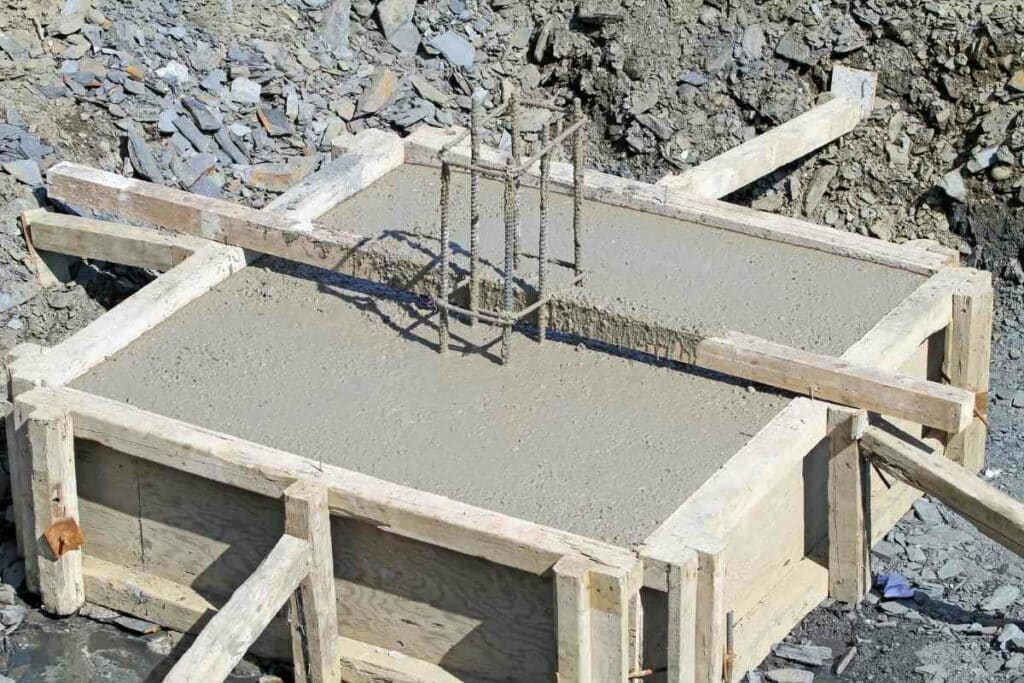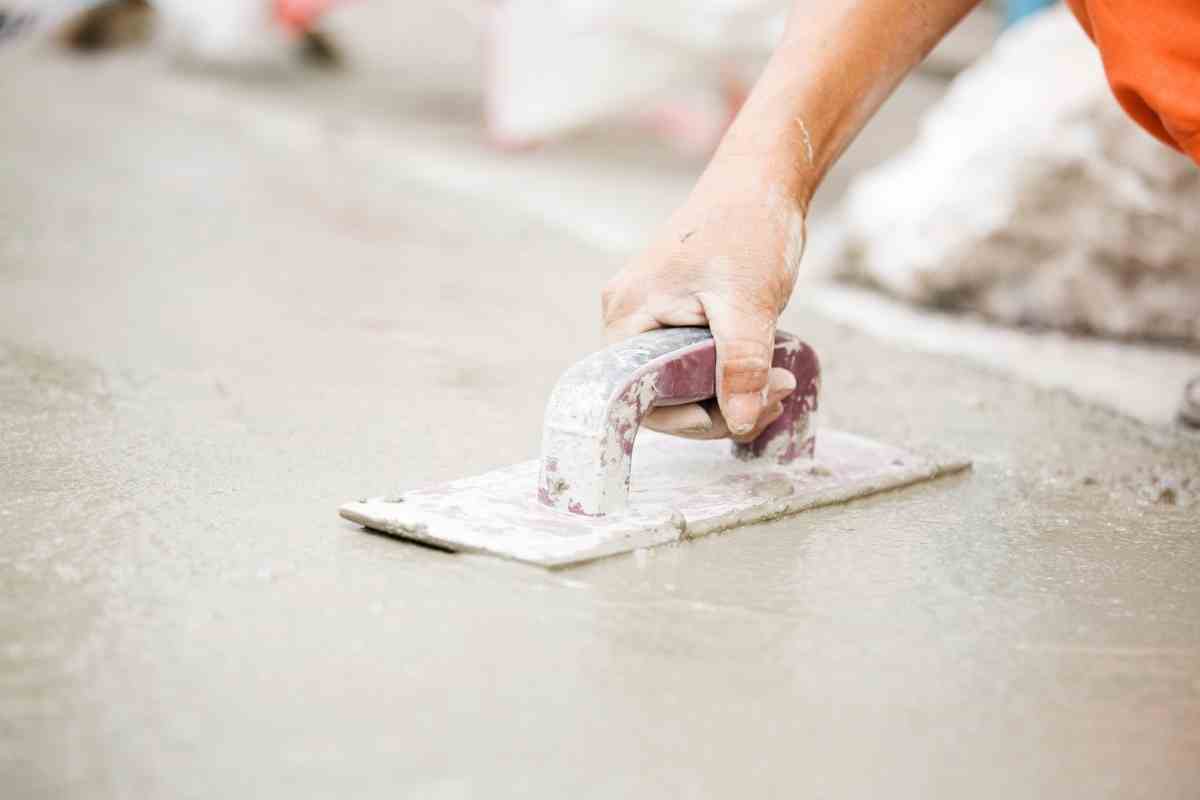Whether you’re building a garden shed or a deck, your foundation is important.
A foundation supports the structure above and prolongs its life by ensuring it doesn’t have direct contact with the ground.
Many DIY enthusiasts often as about deck blocks Vs concrete footings.
So, which is better?
In This Article – We’ll discuss each one in detail to help you decide which to use for your new structure.
What are concrete footings?
Concrete footings are an important element of a foundation.
Whether you’re building a retaining wall, deck, shed, or a large building, you’ll need footings.
Typically, footings are made by excavating a hole, inserting reinforced steel rebars, and pouring in concrete.

Concrete footings serve the purpose of supporting whatever weight is placed on top of them.
For some footings, this is a whole building, while others simply support a single fence post. Concrete footings need to be both stable and strong, especially if the soil around them is weak.
Depending on the structure, many footings will go deep underground below the frost line.
You’ll usually put compacted gravel at the very bottom before pouring the concrete. This is to provide drainage as well as a base level.
Usually, concrete is poured into a form that is removed once the concrete has dried into the desired shape.
What are Deck Blocks?
Deck blocks are simplified precast foundations.
The difference is that these aren’t cast in their final location.
These blocks are recognized in building codes and are subject to the same requirements when used in foundations.
Deck blocks need to have an adequate bearing area. This is the space that the block covers on the ground.
They also need to be placed 12 inches below the frost line. They can’t be placed at ground level. Deck blocks look rather crude but they’re useful.
As their name suggests, they’re most often used to support deck constructions. Though they can be used for outbuildings like sheds.
Pros and Cons of concrete footings
Pros
- Concrete footings are made in-situ, which makes it easier to transport materials.
- As concrete footings are made on-site, there won’t be any flaws or defects from the manufacturing process or transportation.
- Concrete ingredients are readily available all over.
- They are a great option for places with cold winters.
- They provide great stability and support.
- They’re very common and construction workers have been using them for years.
- They support greater loads compared to deck blocks.
Cons
- Installing concrete footings can be expensive.
- They’re time-critical.
- They are difficult to repair when damage occurs.
- They require lots of labor and often need more than one person working on them.
Pros and Cons of deck blocks
Pros
- They are quick to install.
- They don’t require digging.
- They come in different sizes and shapes.
- They can be handled by one person usually.
- They’re usually inexpensive.
- They don’t decay.
- They’re largely resistant to corrosion.
Cons
- Installing them can be costly.
- There may be manufacturing faults or damage from transportation.
- They are not as common.
- They are sometimes unstable depending on the ground they’re placed upon.
- They might not contain steel.
When should you use concrete footings?
Concrete footings are needed in various situations.

These include:
- If you are building a permanent structure that needs frost protection.
- When frost heave regulations apply, you need to use concrete footings instead of deck blocks.
- In places with high uplift or high wind.
- For residential structures.
- When frost heave of the soil is likely.
- With heavy clay soils that hold lots of water.
- For structures on a flood plain.
- For waterfront structures.
When should you use deck blocks?
Deck blocks are used:
- For free-standing and floating structures.
- When below-grade concrete footings aren’t needed.
- Where location means mixing concrete is difficult or transportation of concrete is difficult.
- For freestanding, low structures.
- For small to medium-sized decks.
Deck blocks vs concrete footings – cost differences
Depending on your location, deck blocks can cost between $4 each and $6.
You can find them at many local hardware stores. They usually weigh around 48 pounds each and are typically between 10- and 11-inches square and 7 to 8 inches high.
In Terms of Numbers – Nine evenly spaced deck blocks in a rectangle shape will create a deck 10 feet by eight feet. This would cost between $36 and $54.
For concrete footings to cover the same space, you’re looking at between $3 and $7 per square foot.

For a 10 x 8 space (80 square feet), this would cost between $240 and $560.
Deck blocks are usually cheaper and quicker to install.
The blocks allow for minimal surface preparation and digging, unlike concrete footings. This means the costs of labor are less too.
As you can see, deck blocks are much cheaper.
FAQs – deck blocks vs concrete footings
How should you arrange deck blocks?
You should begin with the corner blocks first and place each footing equidistant apart so that they all bear the same load.
Do I need to put gravel under the deck blocks like when you do concrete footings?
Yes. Gravel secures deck footings and reduces erosion problems that might compromise the structure.
How much weight can each deck block support?
Standard deck blocks can support 1,700 PSI (pounds per square inch) minimum.
Do deck blocks ever sink?
Yes. If the soil below the deck blocks erodes or the deck blocks aren’t bearing even weight, some of them might sink. This is why you should always use more deck blocks, especially in wet conditions or loose soils.
Can you pour concrete footings directly onto the soil?
Yes. However, most people prefer to cover the soil with gravel as a base.
What type of concrete is used for deck footings?
The footings should be structure-strength concrete. It should be around 5000 PSI.
Conclusion – deck blocks Vs concrete footings
Whatever structures you’re building, you need to take the foundations seriously. Unlike concrete footings that you make on-site, deck blocks are precast foundations.
When it comes to deciding whether to use deck blocks vs concrete footings, there’s more to consider than just ease and cost.
Yes, deck blocks are cheaper and quicker to install than concrete footings, but they’re also only suited to certain structures and areas like decks and low-level structures in areas where frost isn’t so much of a problem.
So, if you’re building a small or medium-sized, low-level, freestanding deck, deck blocks could be an option.
You’d also need to be located away from water (not a waterfront property or on a flood plain) and strong winds and uplift.
They should also be in an area where the soil drains well (not clay soils) and where it doesn’t freeze.
In all other situations, concrete footings are your best bet.
